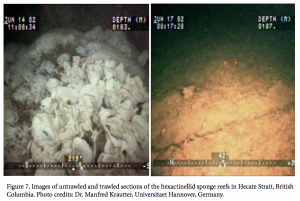Welcome to UBC Blogs. This is your first post. Edit or delete it, then start blogging!
Author Archives: stephan bishop-mercier
Who feeds the fish-feed?
Worldwide, aquaculture and fish farming is presented as an ecologically viable and sustainable alternative to wild-capture fishing for the preservation of wild fish stocks. These intuitive notions, however, are quite misleading when this same industry is a leading contributor to the pressures driving down ocean health, via the use of fishmeal and fish oil (hereby referred to as FMFO) in industrial fish feed. The production of FMFO starts with harmful and unregulated bottom trawling efforts and seems to switch hands enough times before it reaches fishmeal production companies in Europe and North America. Then, they can label it as ‘responsibly sourced’ in compliance with industry sourcing standards. The overconsumption of FMFO has innumerable bottom-up effects on the ocean’s ecosystems that directly contribute to the degradation of our Oceans.

[8], Effects of bottom trawling on coral reefs in BC
I looked at two of the largest fish-feed suppliers in Canada, Skretting Canada and Cargill, trying to evaluate the sustainability efforts boasted on their websites. Using vague terminology and misleading statistics, these companies are basically greenwashing their product. My personal favourite term used by Cargill is “co-product sourcing” which allows them “to utilize nutrients that might otherwise have been regarded as waste”[5] which they claim enhances environmental sustainability. One case study[7] in the south China sea found regular occurrences of unauthorized transshipment (illegally transferring fish from one boat to another) being used for FMFO production. Just because the FMFO used has switched hands from the original producer and is labelled as ‘waste’ these companies can bypass Canadian sourcing standards. Both of these companies publish sustainability reports annually which provide information leading to the original sources of their feed[6].

[6], Cargill’s sourcing locations and feed standards
I think Canadian aquafeed and aquaculture companies are complicit (by association) in these known harmful effects[8]. It is important to acknowledge these complicities to have a better understanding of the impacts of aquaculture.
-Stephan Bishop-Mercier
sources:
[1] Morton A, Routledge R, Hrushowy S, Kibenge M, Kibenge F (2017) The effect of exposure to farmed salmon on piscine orthoreovirus infection and fitness in wild Pacific salmon in British Columbia, Canada. PLoS ONE 12(12): e0188793. https://doi.org/10.1371/journal.pone.0188793
[2] Morton A, et al(2016). Salmon Confidential: The ugly truth about Canada’s open-net salmon farms. obtained: http://www.alexandramorton.ca/salmon-confidential-booklet/
[3] Pure Salmon Campaign(2004) Waste Contamination of Salmon Farms. obtained: https://nsapes.ca/sites/default/files/attachments/waste_0.pdf
[4]Scott Wallace, Bruce Turris, John Driscoll , Karin Bodtker, Brian Mose, Gordon Munro (2015) Canada’s pacific groundfish trawl habitat agreement: A global first in an ecosystem approach to bottom trawl impacts. Journal of Marine Policy, obtained: https://davidsuzuki.org/wp-content/uploads/2018/06/canada-pacific-groundfist-trawl-habitat-agreement.pdf
[5] Cargill Website(2021), Aquaculture Sourcing standards. obtained: https://www.cargill.com/sustainability/aquaculture/aquaculture-sourcing-standards
[6]Cargill Aqua Nutrition Sustainability Report (2019). “Healthy seafood for future generations’ obtained: https://www.cargill.com/doc/1432142322239/cargill-aqua-nutrition-sustainability-report.pdf
[6b]Skretting North America’s Sustainability report (2017), obtained: https://www.skretting.com/globalassets/skretting-vancouver/sustainability-reports/skretting-north-america-sustainability-report-2017
[7]Changing Markets Foundation (2019), Fishing for Catastrophe. obtained: https://changingmarkets.org/wp-content/uploads/2019/10/CM-WEB-FINAL-FISHING-FOR-CATASTROPHE-2019.pdf
[8] Scott Wallace (2007 @ David Suzuki Foundation) Dragging Our Assets: Toward an Ecosystem Approach to Bottom Trawling in Canada. obtained: https://davidsuzuki.org/wp-content/uploads/2019/01/dragging-assets-ecosystem-approach-bottom-trawling.pdf
It was really hard getting this under 500 words! I wish I could have continued and made myself clearer with more words